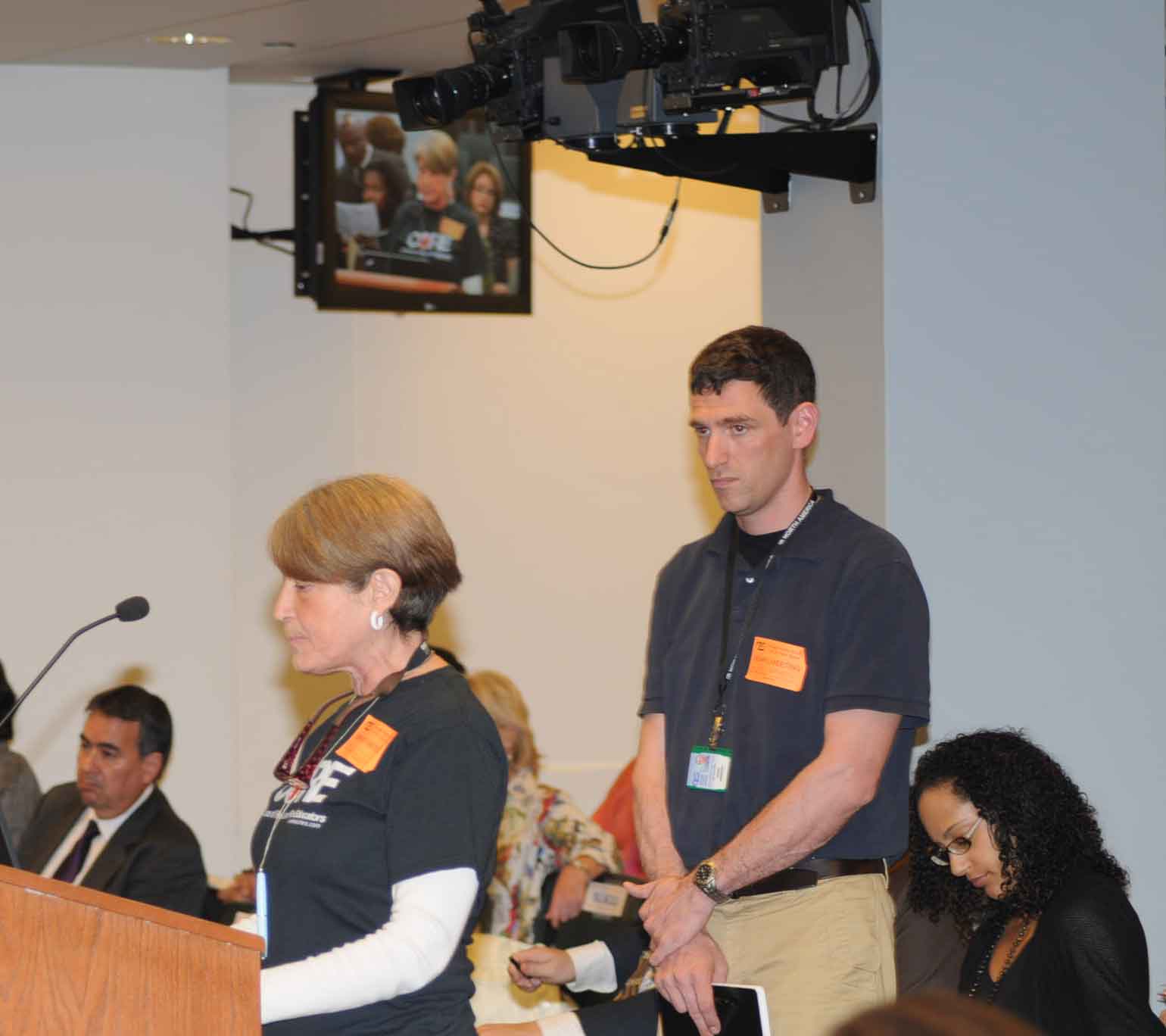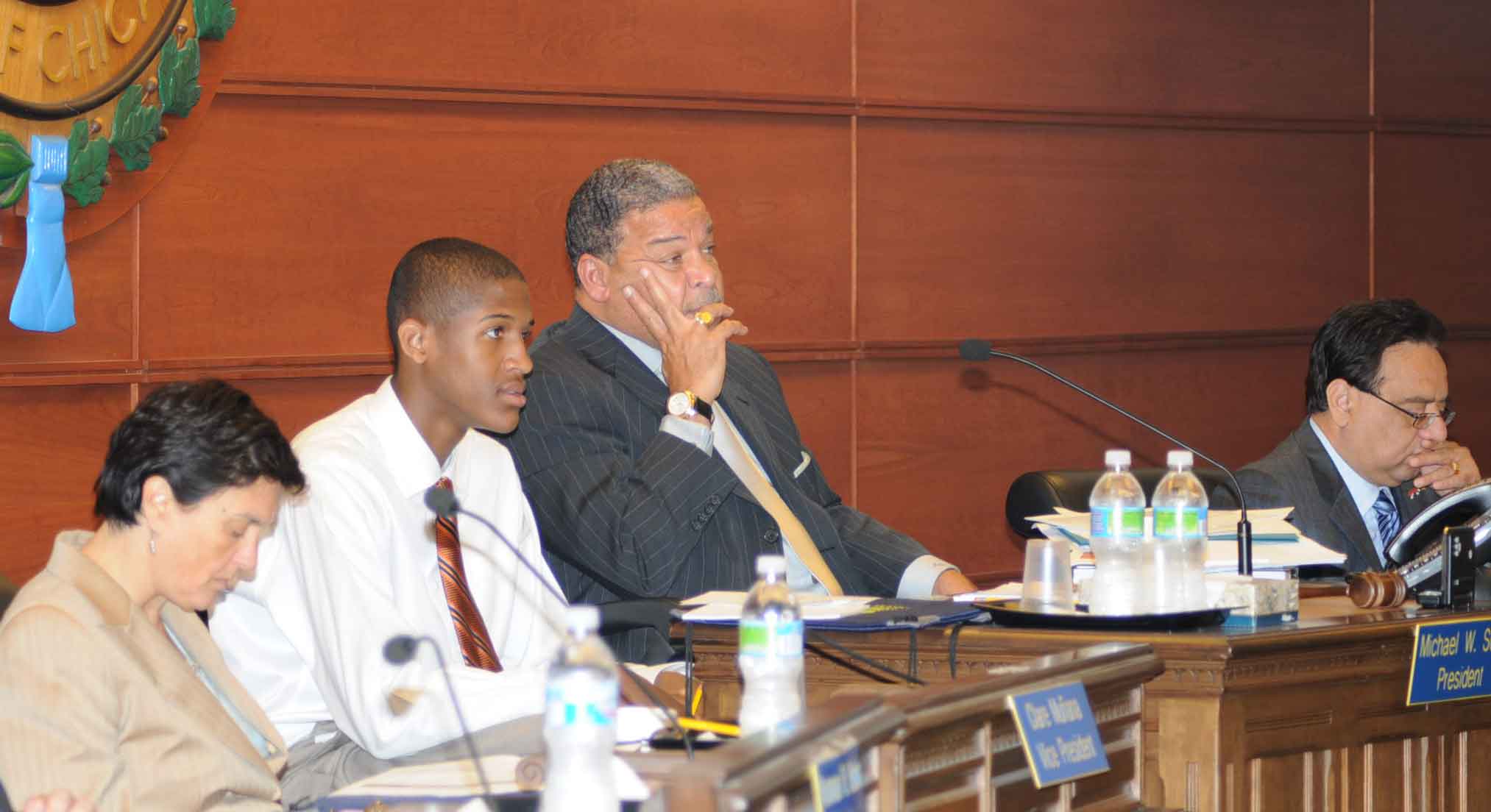CORE continues focus on disruptions of schools in citing '20th Day closings' to May 27 Board meeting
Members of the Caucus of Rank and file Educators continued to challenge the Chicago Board of Education's systematic sabotage of the city's general high schools and neighborhood elementary schools at the Board's May 27, 2009 meeting.
 Carol Caref of CORE explains the disruption of schools by the Board's policy of closing teaching positions after school opens and asks the Board to change the policy. Above, Caref speaking at the May 27 Board meeting while Jesse Sharkey looks on. Substance photo by George N. Schmidt.CORE teacher activist Carol Caref reported on the Board's position closings from last school year, noting how disruptive those policies are to the schools that are hit by them.
Carol Caref of CORE explains the disruption of schools by the Board's policy of closing teaching positions after school opens and asks the Board to change the policy. Above, Caref speaking at the May 27 Board meeting while Jesse Sharkey looks on. Substance photo by George N. Schmidt.CORE teacher activist Carol Caref reported on the Board's position closings from last school year, noting how disruptive those policies are to the schools that are hit by them.
Caref's prepared remarks were read:
As in years past, this September, students will be encouraged to attend school from day one, to start the year off right. However many of these same students will have a rocky start to their year. They will be subject to program changes, overcrowded classes, and/or substitute teachers. You, Dr. Eason-Watkins, [I originally had Ron Huberman, but he wasn't there], and you, Board of Education members, can make a simple policy change that will guarantee a smoother start for thousands of students.
Current CPS practice is to open and close teaching positions as late as October.
Last year, on September 30, 132 positions in 59 schools were closed.
 Chicago Board of Education President Michael Scott listened attentively while CORE's Carol Caref described the huge disruption to schools when the Board closes teaching positions after the school year has begun. Other members of the Board, including Clara Muñana (far left above) and Tariq Butt (right, above) ignored Caref and busied themselves reading from other materials. Substance photo by George N. Schmidt.CPS is allowed to do this by state law, but it is not compelled to do so. I respectfully submit that students would be much better served if teachers in place on day one stayed in place the entire school year. Yes, eliminating teachers because enrolment turned out to be lower than expected does save money. But is the chaos caused when teachers are laid off after the school year starts worth it? And does it really save money, or does it just shift expenses to summer school or after school programs which might not have been necessary if the school had gotten off to a good start?
Chicago Board of Education President Michael Scott listened attentively while CORE's Carol Caref described the huge disruption to schools when the Board closes teaching positions after the school year has begun. Other members of the Board, including Clara Muñana (far left above) and Tariq Butt (right, above) ignored Caref and busied themselves reading from other materials. Substance photo by George N. Schmidt.CPS is allowed to do this by state law, but it is not compelled to do so. I respectfully submit that students would be much better served if teachers in place on day one stayed in place the entire school year. Yes, eliminating teachers because enrolment turned out to be lower than expected does save money. But is the chaos caused when teachers are laid off after the school year starts worth it? And does it really save money, or does it just shift expenses to summer school or after school programs which might not have been necessary if the school had gotten off to a good start?
Last September 30, 159 positions in 82 schools were opened. Again, I respectfully submit that there is no reason not to open positions immediately. The policy should be that when Impact shows enrollment sufficient to justify another teaching position, that position should be opened and filled as soon as possible.
Finally, at one point, Arne Duncan agreed with these ideas. In a September, 2004, letter to CTU president Marilyn Stewart, he stated that schools would no longer be subject to the 20th day reduction in force, and that positions would be opened at the earliest stages of the school year. Let’s get the 2009-2010 school year off to a good start by keeping staff in place from day one and staffing new positions as soon as needed.

